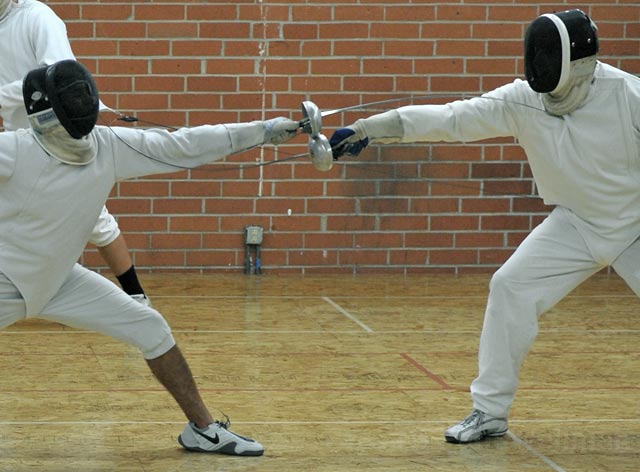Fencing Is Fun
How One Stanford Student Found Out Where to Fence in Santa Barbara

When I tell people that I fence, one of the most common responses I get is, “Oh really? I tried that once in college,” as if the activity were on par with smoking pot or sexual experimentation. Understandably, fencing has always been an obscure activity eclipsed by other sports in the United States; equipment prices and floor fees can get costly, fencing clubs are few and far between, especially on the West Coast, and it isn’t something you’ll find yourself mastering overnight.
So when it came time for me to move down from the Bay Area to Santa Barbara for the summer, I was skeptical I would even find a place to fence between San Luis Obispo and Los Angeles. Plus, even finding a fencing club doesn’t always translate into a viable option. There are three distinct weapons — the saber, epee, and foil — and not every club will have enough interested fencers to accommodate each. Interchanging weapons in fencing is roughly equivalent to switching between racquet sports; you have to adjust to different equipment, different game tempos, and different target areas to either hit the ball or the opponent.
But I was determined, because I needed to be prepared for an invitational tournament with my collegiate team in Korea in August. Fortunately, I stumbled upon Presidio Fencing, a foil and epee club nestled a few blocks off State Street on Cota Street.
The club is owned and run by the UCSB team coach, Tim Robinson. After a couple of years competing with dance classes for floor space in various Santa Barbara studios, he found a place to set up a club in the Magnolia Shopping Center in 2006, and then moved the club to its current downtown location in 2009.
Taking it upon himself to make sure I always had someone to fence at the club, Robinson is largely responsible for me being able to remember the difference between a fencing epee and a stick. He’s one of the most personable coaches you’ll ever meet, and it enables him to be particularly adept at coaching younger fencers. And I’m not the only one to notice: In 2008, he was honored with the “Coach of the Year” award from SBParent.com.
His club hosts a variety of foil and epee fencers of all levels, along with a handful of his UCSB students (Robinson himself picked up fencing back when he was a college freshman at UCSB) who stick around over the summer. Some of them have been fencing way before I was born and others have literally started since my last haircut. The U.S. Fencing Association has age categories ranging from 8 years old to 70-plus, and a lettering system that gives you an A (the highest) to E rating based on your personal best USFA-sanctioned tournament results.
At almost every stage of the sport you’ll find people of different shape, sizes, and styles. Some are adept at whipping their weapon in a flick to the hand or arm, while others have powerful parries, or lightning-fast fleche attacks, or simple but supremely effective tempo adjustment and timing, or even well-coordinated behind-the-back strikes at a passing opponent.
People infatuated with the sport tend to be as distinctive and interesting on the fencing strip as they are off of it. Some of the regulars include Randy Bublitz, chef and culinary arts department chair at SBCC, and his son Oliver; Gage Delany, a foil fencer who participated in Presidio’s first Youth class but now is a coaching assistant and college student; and Tom Pingel, an avid weapons and mechanical repair man dubbed the club’s “resident epee god” by Robinson.
Chat with a couple fencers and you’re bound to hear from those who’ve used their sword-wielding abilities to travel the world, to knock the wind out of someone on a day when you just need to let out some tension, and to even get college scholarship opportunities. But it’s not always an easy road to walk down initially, as Robinson noted, “Sword-fighting is romanticized in movies and literature, but fencing is actually very hard. It requires quick, analytical thinking, strong legs, and efficient, fast movements, especially in the hands and fingers. Many people coming in the door to try out fencing do not realize how hard it is to refine the movements necessary to fence well.”
Despite the allure of the sport, it will, in all likelihood remain both hard to hear about and hard to do. “We run demonstrations occasionally,” Robinson said, “Most of our outreach is through word of mouth, though.”
To find out more about the sport of fencing and local fencing options, visit Presidio Fencing’s Web site at presidiofencing.com.



